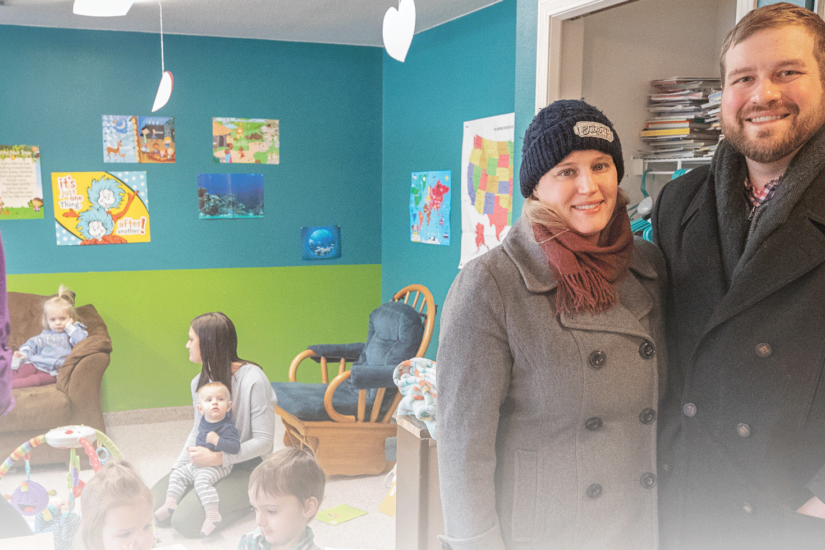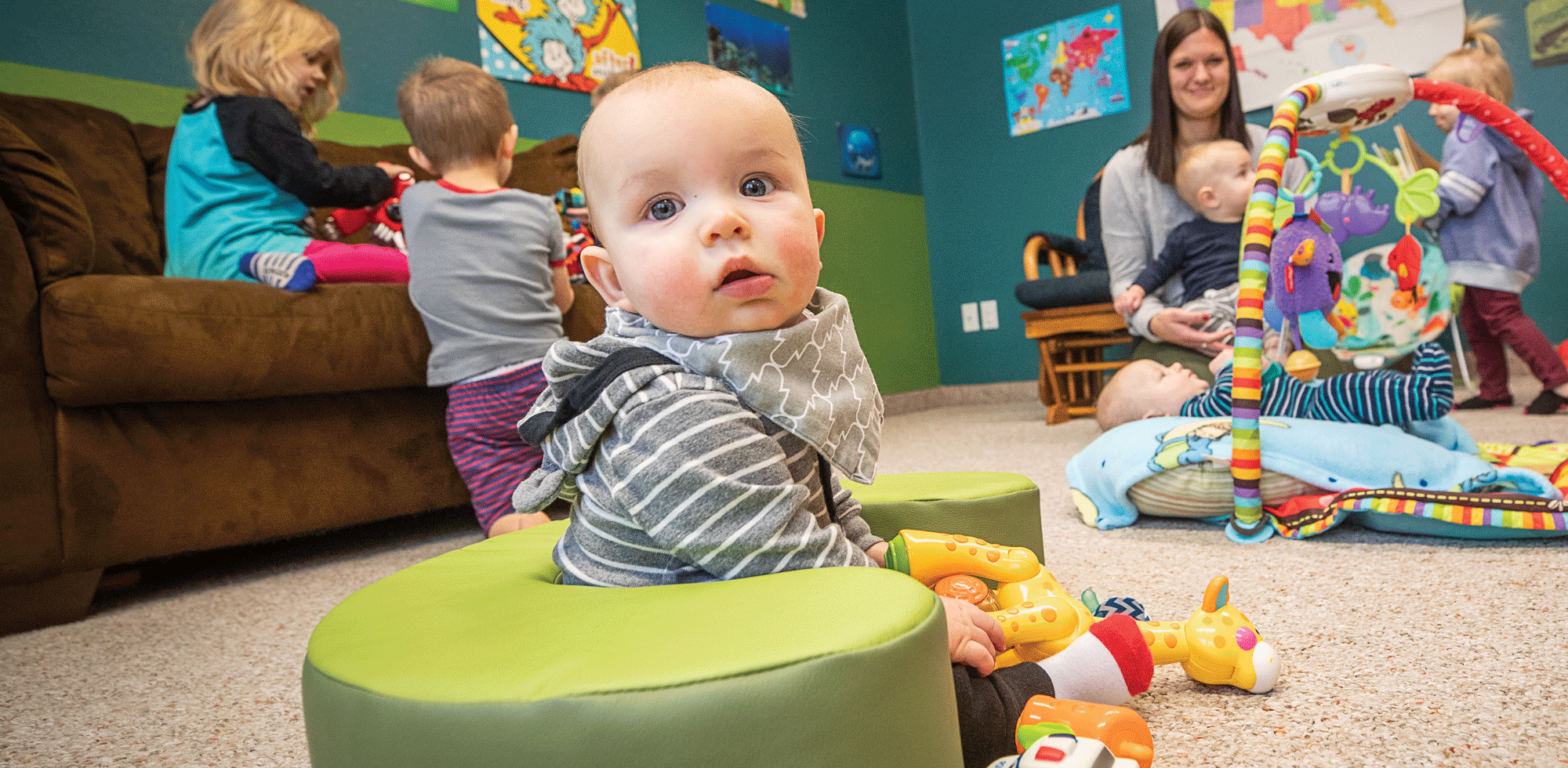
Searching for Civic Solutions
Central Minnesota’s child care shortage makes it hard for the region to attract new workers. Local communities are uniting to solve the challenge.
By Andy Steiner | Photography by John Linn
When Jon and Sarah Radermacher’s first child, Charlie, was born, the couple embarked on an epic struggle to find a daycare provider in their hometown of Madison, Minn. “Nobody had an opening,” Radermacher recalled about contact- ing child care providers in Madison. “Everybody had a waiting list. The soonest opening was eight months after he was born, and most lists were one to two years out.”
With the help of extended family, a part-time nanny and Sarah’s understanding employer, the Radermacher family eventually pieced together a patchwork child care plan. Then Radermacher was approached about applying for a job as the city administrator in Little Falls.
The position felt ideal, but Radermacher wasn’t ready to bite until he learned more about the daycare situation in town. “I wasn’t going to move anywhere if there wasn’t a child care option for my kid,” he said. “We’d already been through that.”

WORKFORCE ISSUE
The Radermachers are committed to living in Greater Minnesota, but the child care struggles their family has faced were enough to make them consider moving to a more populated part of the state where it’s easier for working parents to find high-quality care for their children. They know they are not alone in these concerns, and as a small-town booster, Jon hopes communities can develop strategies to help improve child care opportunities for families who would like to settle there.
“The lack of child care in rural communities is an incredible workforce issue,” he said. “We have low unemployment rates in the region, with local employers that are hiring for all different positions.” Communities like Little Falls and Madison are filled “with two-parent households that would like to have both spouses working, but there is no place for their kids to go for daycare. This situation is holding us back.”
In fact, families often need to make tough choices between career advancement and family well-being. “In Central Minnesota we have more than 17,000 parents with children in need of child care who can’t find it,” said Don Hickman, Initiative Foundation vice president for community and workforce development. “In many cases, parents are choosing to withdraw from the workforce or are reliant on family and friends to care for their kids.”
SEARCHING FOR SOLUTIONS
If Greater Minnesota communities want to thrive into the future, residents, business owners and other stakeholders will need to figure out how to create child care options that work for everyone. To encourage locally based innovation, the Initiative Foundation has teamed with First Children’s Finance, a nonprofit that provides loans and business assistance to high-quality child care providers serving low- and moderate-income families, and the Minnesota Department of Human Services to offer challenge grants to rural communities interested in exploring and developing innovative solutions to the regional child care shortage.
“A lot of employers in the region are now asking, ‘How can we come to the table and develop solutions to this child care shortage?’” said Heidi Hagel Braid, chief program officer for First Children’s Finance. In a labor market with jobs for the taking, local employers are anxious for solutions. While local factories can sometimes offer split-shift options so parents that work for the same employer can avoid child care costs, it’s harder to attract high-skilled, high-wage workers like physicians to small towns with limited care options for their kids. When that happens, the child care shortage “hurts everyone, not just people with kids, but the whole community,” Hagel Braid said.
Municipalities taking part in the Child Care Solutions pilot program will work with First Children’s Finance to explore unique barriers to quality, affordable care in their community and identify opportunities to create additional child care slots to narrow the gap. Upon completion of a strategic plan, each community will be awarded a $10,000 matching grant to implement their goals. The matching portion of the grant is designed to boost community buy-in. “The goal is to gain financial commitments from public and private sources so that effective solutions can be gained and sustained,” Hickman said.
By involving a range of community members in the brainstorming and planning process, the project’s funders hope to build a community-wide sense of the importance of quality child care for everyone in town—not just to parents and kids.
“We may need to start thinking about high-quality child care as similar to how many communities view a public library or a swimming pool,” said Hickman. “They are public services that don’t always cashflow themselves, but they are considered important enough to the community that public or private investments are made. Communities that don’t offer services like quality, affordable child care will be at a disadvantage for attracting or retaining skilled workers or young families.”

NEW OPTIONS
That sense of child care as a community asset wasn’t yet in place when Jon Radermacher was offered the job in Little Falls. The couple began researching daycare options, only to run into a situation that was similar to what they had faced in Madison. “There were waiting lists of six to eight months out for the ones that did have openings,” said Radermacher.
He accepted the job offer, with the caveat that he’d move to town ahead of his family, allowing a few months to find full-time care for his son. If nothing came through, he’d have to resign and move back to Madison. The arrangement was less than ideal, but it was the only option that worked for his family.
Once he’d settled in a temporary apartment in Little Falls, Radermacher said he was on a mission. “The first thing I brought up with everybody I met was child care,” he said. “I was talking about it all the time.”
All that talking worked. After living in town for a couple of months, Radermacher met a woman who said she was interested in caring for an infant along with her own child. It sounded like a plan, and so Radermacher and his wife met with her, made the necessary arrangements, and his whole family finally made the move to Little Falls, settling in for good.
“It’s not something we enjoyed dealing with at all,” he said of the long and frustrating process. “And I hate to think that that’s what’s happening to other people who want to move to town, too. This is a community issue, something we need to support to keep our towns alive.”
When their second child, Marie, was born, the Radermachers once again had to scramble to find care. “There is no single silver-bullet solution that is going to solve this problem,” Jon Radermacher said. But he hopes the Initiative Foundation’s new pilot program and grant opportunities will encourage communities to keep working toward long-term solutions. “This issue is important for everyone,” Radermacher said, “and once more people realize that, I’m confident that new options will start to emerge.”